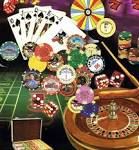Compulsive Behaviors
It’s In the Game, or Is It?
What is the role of game type and the development of gambling addictions?
Posted February 11, 2013

Which games are addictive?
A few weeks ago, I (and my research colleague Michael Auer) published a paper arguing that the type of game that people gamble on is irrelevant in the acquisition, development, and maintenance of pathological gambling. We argued that the most important factors along with individual susceptibility and risk factors of the individual gambler are the structural characteristics relating to the speed and frequency of the game rather than the type of game.
Event frequency refers to the number of events that are available for betting and gambling within any given time period. For example, a lottery draw may occur once a week but a slot machine may allow 15 chances to gamble inside one minute. In this example, slot machine gambling has a higher event frequency than lottery gambling. Bet frequency refers to the number of bets or gambles placed in any given time period. Using lottery playing as example, Dr. Jonathan Parke and I noted in a 2007 book chapter on structural characteristics, that multiple tickets (e.g., 10 tickets) can usually be purchased as frequently as desired before any single lottery draw. In this instance, bet frequency would be equal to 10 but event frequency would be equal to 1. Therefore, event frequency can often be much lower than bet frequency and it is possible for players to spend more than they can afford even with a low event frequency.
Another important gaming parameter is event duration. This refers to how fast the event in question is (e.g., a reel spin on a slot machine might last three seconds). Here, it is important to note that duration of the betting/gambling event is different from event frequency (although they may be inextricably linked in so much as the length of a betting event will obviously limit the frequency with which they can take place). Again, Dr Parke and I noted that a betting event lasting two hours (e.g., a soccer game) could not have an event frequency greater than one in any 2-hour period but could have a betting frequency of over 100 with the advent of in-play betting.
In-play betting and gambling refers to the wagering on an event that has started but has not yet finished. This means gamblers can continue to bet on an event (e.g., a soccer omatch) and perhaps more importantly, adapt their bets according to how the event is progressing. For instance, in the UK, during the playing of almost any soccer match, a gambler can bet on everything from who is going to score the first goal, what the score will be after 30 minutes of play, how many yellow cards will be given during the game and/or in what minute of the second half will the first free kick be awarded. ‘In-play’ gambling activities have taken what was traditionally a discontinuous form of gambling – where a gambler made one bet every weekend on the result of the game – to one where a player can gamble continuously again and again. In short, the same game has been turned from what was a low event frequency gambling activity into a potentially high frequency one (and gone from an activity that had little association with problem gambling to one where problem gambling is far more likely among excessive in-play gamblers).
To highlight the irrelevance of game type, consider the following two examples that demonstrate that it is the structural characteristics rather than the game type that is critical in the acquisition, development and maintenance of problem and pathological gambling for those who are vulnerable and/or susceptible. A “safe” slot machine could be designed in which no-one would ever develop a gambling problem. The simplest way to do this would be to ensure that whoever was playing the machine could not press the ‘play button’ or pull the lever more than once a week. An enforced structural characteristic of an event frequency of once a week would almost guarantee that players could not develop a gambling problem. Alternatively, a problematic form of lottery could be designed where instead of the draw taking place weekly, bi-weekly or daily, it would be designed to take place once every few minutes. Such an example is not hypothetical and resembles lottery games that already exist in the form of rapid-draw lottery games like keno.
The general rule is that the higher the event frequency, the more likely it is that the gambling activity will cause problems for the individual (particularly if the individual is susceptible and vulnerable). Problem and pathological gambling are essentially about rewards, and the speed and frequency of those rewards. Almost any game could be designed to either have high event frequencies or low event frequencies. Therefore, the more potential rewards there are, the more problematic and addictive an activity is likely to be and this is irrespective of game type as games such as diverse as lotteries and slot machines could have identical event frequencies and event durations.


